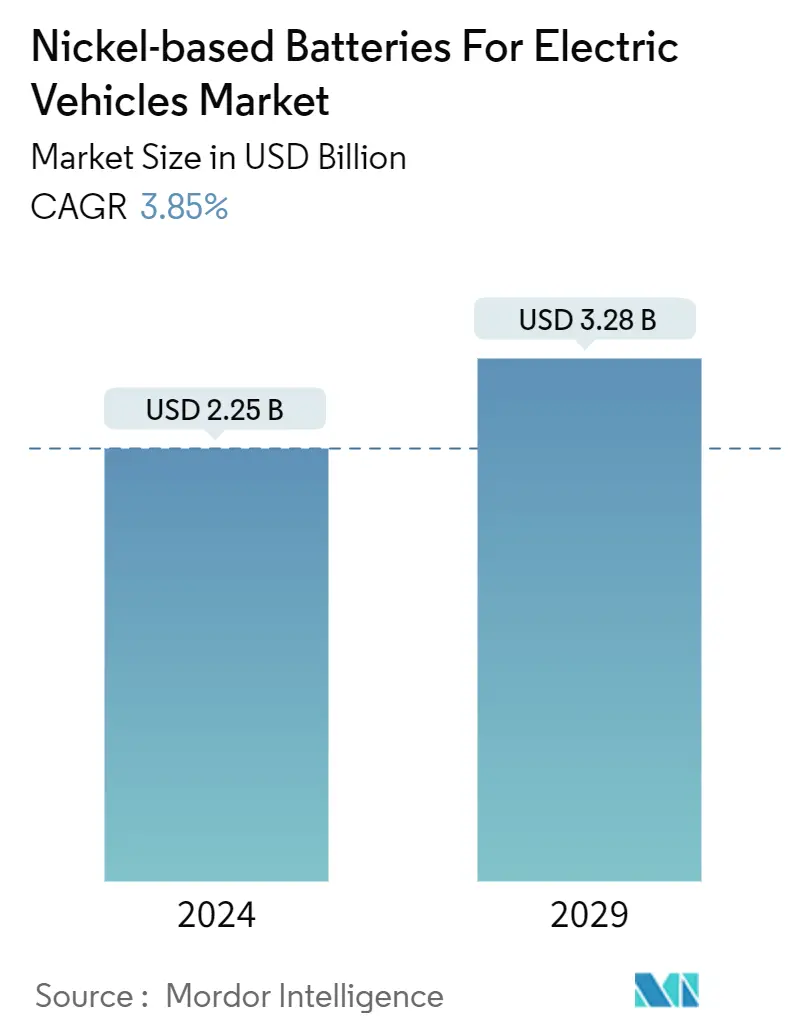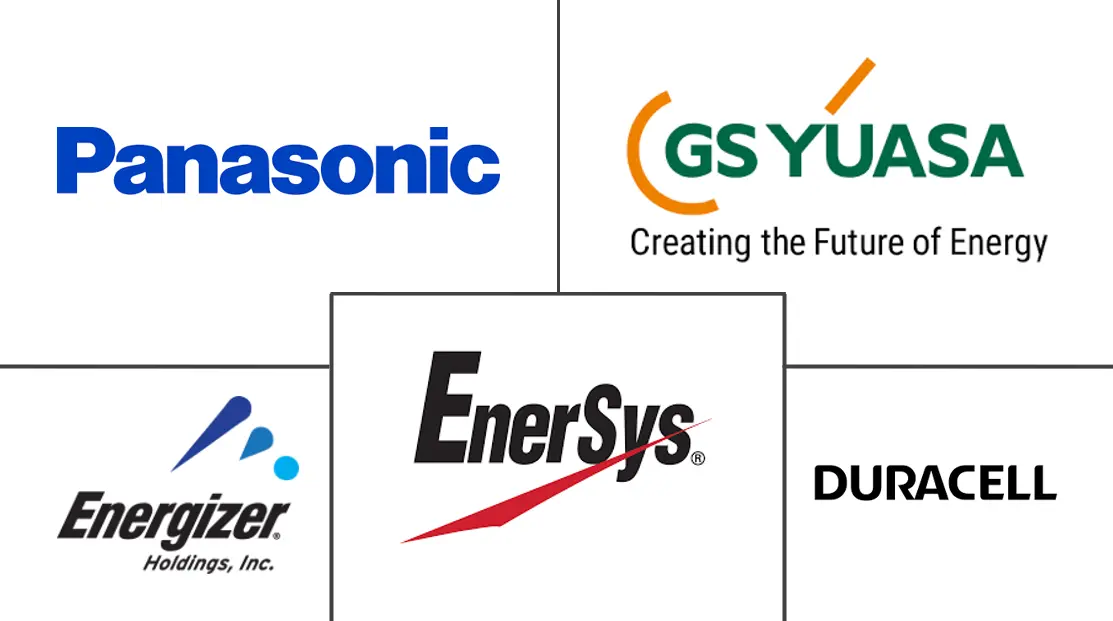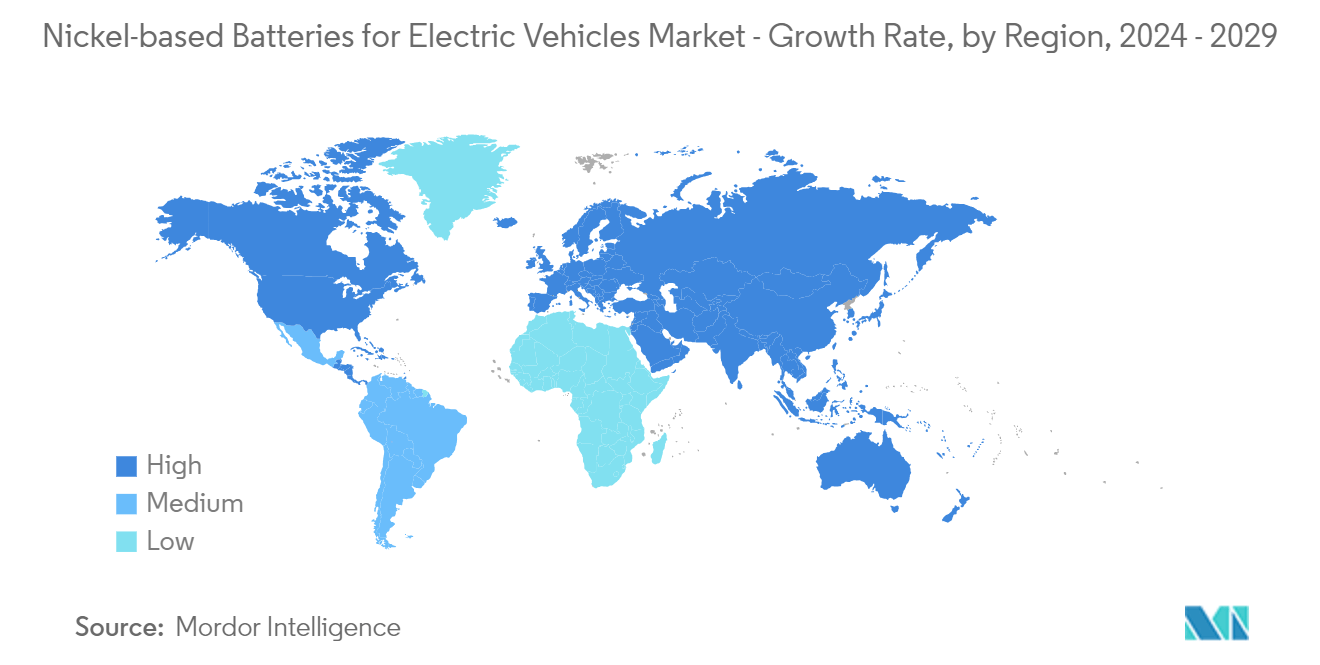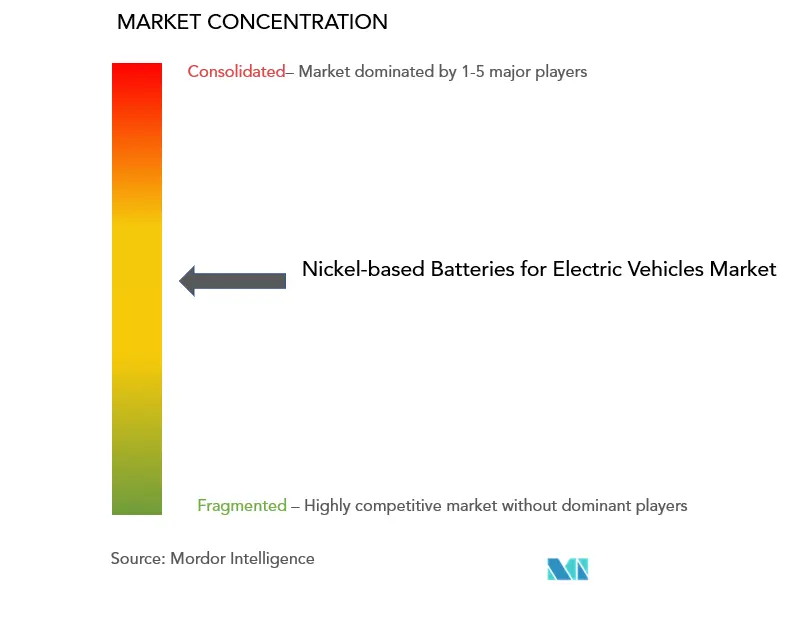Nickel-based Batteries For Electric Vehicles Market Size

| Study Period | 2019 - 2029 |
| Market Size (2024) | USD 2.25 Billion |
| Market Size (2029) | USD 3.28 Billion |
| CAGR (2024 - 2029) | 3.85 % |
| Fastest Growing Market | Europe |
| Largest Market | Asia Pacific |
| Market Concentration | Medium |
Major Players
*Disclaimer: Major Players sorted in no particular order |
Nickel-based Batteries For Electric Vehicles Market Analysis
The Nickel-based Batteries For Electric Vehicles Market size is estimated at USD 2.25 billion in 2024, and is expected to reach USD 3.28 billion by 2029, growing at a CAGR of 3.85% during the forecast period (2024-2029).
Over the long term, rapid technological developments in the electric vehicle industry are expected to drive nickel-based batteries for the electric vehicle market. Improvements in design and manufacturing, changing consumer preferences, growing concern about sustainability and climate change, and governmental regulatory pressures and measures continue to transform the structures and systems that underpin the automotive industry. An example of such transformation is the rapid rise in the demand for electric vehicles.
The cost advantages of electric vehicles over conventional vehicles and other factors are expected to help the electric vehicle battery market expand. Moreover, supportive government policies to promote electric vehicle sales are expected to increase the demand for nickel-based batteries for electric vehicles over the forecast period.
However, the high cost of electric vehicles, the demand-supply gap of vital raw materials such as cobalt, and the lack of charging infrastructure are expected to restrain the market's growth. Leading automakers are working with battery companies to take advantage of the rapidly expanding electric vehicle industry.
As a result of major automakers showing interest in the electric vehicle sector, there is a rising need for electric vehicle batteries. However, many electric vehicle manufacturers are focusing on developing battery packs themselves. These factors are expected to drive the market during the forecast period.
Nickel-based Batteries For Electric Vehicles Market Trends
Battery Electric Vehicle Segment Anticipated to Dominate the Market
The rising demand for sustainable transportation and cleaner energy has increased the demand for battery electric vehicles. Promotional activities and government legislation are solving consumer constraints such as vehicle range, greater upfront prices, limited model availability, and lack of knowledge. These factors are expected to impact the demand for battery electric vehicles, which will drive the nickel-based batteries for the electric vehicles market.
- Battery-electric vehicle sales reached an estimated 7.3 million in 2022, up from around 4.6 million in 2021. BEV sales have soared due to several factors, including an increased consumer interest in more sustainable transport and governmental regulations to curb direct transport emissions. In 2021, these sales more than doubled compared to 2020, and 2022 witnessed a new record in all-electric sales volume.
Nickel plays a vital role in electric vehicle batteries. It is used in the production of electric batteries. This material is used as the basis for lithium-ion batteries, which are a very common energy source in electric vehicles. Moreover, nickel weighting in battery electric vehicles jumped 8% yearly to an average of 25.3 kilograms in July 2023 as carmakers continue to opt for high-nickel batteries for long-range, performance, and many entry-level new models.
In recent years, a few automakers have been gradually developing business strategies that take electrification into account to increase market share and keep a competitive edge. Companies have kept their stance in a way to comply with policy regulations or in response to government incentives. Companies have also announced their plans with a greater choice of models to be rolled out sooner over the coming years, propelling the nickel-based batteries market over the forecast period.
- Toyota, the world’s largest car manufacturer, plans to roll out 30 BEV models by 2030. The company aims for 3.5 million annual sales of electric cars. Lexus aims to achieve 100% BEV sales globally in 2035.
- Volkswagen announced that all-electric vehicle sales would exceed 70% of its European and 50% of its Chinese and US sales by 2030. By 2040, nearly 100% of vehicles should be zero-emissions. On the other hand, Volvo is committed to becoming a fully electric car company by 2030.
Owing to these factors, the adoption of nickel-based batteries in electric vehicles is increasing globally. Such positive trends are expected to enhance the growth of the nickel-based batteries market over the forecast period.

Asia-Pacific Region is Expected to Dominate the Target Market
Asia-Pacific is expected to have a majority share in the global nickel-based batteries market. Rising disposable income and an increase in GDP in the region are driving the market. Ease of manufacturing auto parts, vehicle sales, growing government regulations, and robust expansion adopted by original equipment manufacturers and suppliers in the region to accommodate rising demand from the automotive industry across the region are expected to create a positive outlook for the market during the forecast period.
China is one of the largest markets for electric vehicles, and the increasing adoption of electric vehicles in the country has been in line with the clean energy policy. Moreover, the Chinese government has been providing both financial and non-financial incentives to promote the adoption of electric vehicles.
- For instance, in 2022, China produced around 5.47 million battery-electric vehicles, an increase of 85.8% compared to 2021. In the same year, around 1.59 million plug-in hybrid cars were produced in China, an increase of 164.2% compared to the previous year.
Furthermore, the Government of India is targeting the conversion of two and three-wheelers into 100% electric ones and the total automotive sales to 30% into e-mobility by 2030. Currently, India is dependent on other countries to source EV batteries, which has resulted in the hiked price of EVs. The penetration of EVs in the Indian automotive sector is expected to bolster indigenous manufacturing of Li-Ion batteries and make them economically viable.
- In June 2023, Japan’s Ministry of Economy, Trade, and Industry announced that it would invest JPY 127.6 billion (USD 900 million) in Toyota Motor Corporation and other companies for seven projects relating to the technical development and capital investment for storage batteries and their parts.
Due to such developments, the electric vehicles industry is expected to see significant growth and create opportunities for the nickel-based batteries market over the forecast period.

Nickel-based Batteries For Electric Vehicles Industry Overview
The nickel-based batteries for electric vehicles market is moderately consolidated. A few prominent companies include Panasonic Holdings Corporation, FDK Corporation, Energizer Holdings Inc., GS Yuasa International Ltd, and EnerSys. Several companies in the market are focusing on improving their product portfolios to widen their customer base. Some other key players aim to expand their presence in the market through product launches, offerings expansion, manufacturing expansion, and collaborations with other companies. For instance,
- In October 2023, LG Energy Solution and Toyota Motor Corporation signed a long-term deal for Nickel-based lithium-ion battery modules to power Toyota's electric vehicles in the United States. Starting in 2025, LG Energy Solution will supply 20 GWh annually, investing USD 3 billion in the endeavor. The high-nickel NCMA pouch-type cells will be produced at LG Energy Solution's Michigan facility.
- In September 2023, Atlas Materials successfully secured USD 27 million in funding for the electric vehicle nickel-based batteries. This financial support comes ahead of the startup's plans to construct a manufacturing plant in North America. Atlas, headquartered in the United States, targets the commencement of large-scale production at one of three potential locations in Canada or the United States by 2027, aiming for an annual nickel output of 1,800 metric tons.
Nickel-based Batteries For Electric Vehicles Market Leaders
-
Panasonic Holdings Corporation
-
GS Yuasa International Ltd.
-
EnerSys
-
Energizer Holdings Inc.
-
Duracell
*Disclaimer: Major Players sorted in no particular order

Nickel-based Batteries For Electric Vehicles Market News
- January 2023: Stellantis NV and Terrafame Ltd officially inked a supply deal for nickel sulfate, a crucial component in electric vehicle (EV) batteries. Commencing in 2025, Terrafame, headquartered in Finland, will serve as the supplier for Stellantis, providing nickel sulfate over five years. This collaboration aligns with Stellantis' robust electrification strategy and addresses a substantial portion of the company's demand for environmentally sourced nickel within the region.
- November 2023: LG Energy Solution Ltd, a South Korea-based company, is set to accelerate the mass production of mid-nickel, high-voltage lithium batteries, aiming to commence operations a year earlier than initially planned. This strategic move responds to the growing trend among electric vehicle manufacturers to embrace cost-effective battery solutions, contributing to the overall objective of lowering electric vehicle prices.
Nickel-based Batteries For Electric Vehicles Market Report - Table of Contents
1. INTRODUCTION
1.1 Study Assumptions
1.2 Scope of the Study
2. RESEARCH METHODOLOGY
3. EXECUTIVE SUMMARY
4. MARKET DYNAMICS
4.1 Market Drivers
4.1.1 Increasing Demand for Electric Vehicles Drive the Market Growth
4.2 Market Challenges
4.2.1 Shortages of Raw Materials May Create Short Term Hurdles
4.3 Industry Attractiveness - Porter's Five Forces Analysis
4.3.1 Bargaining Power of Suppliers
4.3.2 Bargaining Power of Buyers/Consumers
4.3.3 Threat of New Entrants
4.3.4 Intensity of Competitive Rivalry
4.3.5 Threat of Substitute Products
5. MARKET SEGMENTATION
5.1 By Propulsion Type
5.1.1 Battery Electric Vehicles
5.1.2 Hybrid Electric Vehicles
5.1.3 Plug-in Hybrid Electric Vehicles
5.1.4 Fuel Cell Electric Vehicles
5.2 By Type
5.2.1 Nickel Cadmium
5.2.2 Nickel Metal Hydride
5.2.3 Others (Nickel Iron, Nickel Zinc, etc.)
5.3 By Vehicle Type
5.3.1 Passenger Cars
5.3.2 Commercial Vehicles
6. COMPETITIVE LANDSCAPE
6.1 Vendor Market Share
6.2 Company Profiles
6.2.1 EnerSys
6.2.2 GS Yuasa International Ltd
6.2.3 Energizer Holdings Inc.
6.2.4 Panasonic Holdings Corporation
6.2.5 Duracell
6.2.6 Varta AG
6.2.7 FDK Corporation
6.2.8 BYD Company
6.2.9 Primearth EV Energy Co. Ltd
6.2.10 GP Batteries International
6.2.11 Saft Group
6.2.12 HBL Batteries
6.2.13 Alcad ab
- *List Not Exhaustive
7. MARKET OPPORTUNITIES AND FUTURE TRENDS
Nickel-based Batteries For Electric Vehicles Industry Segmentation
Nickel-based batteries for electric vehicles are energy storage devices utilizing nickel compounds, such as nickel-metal hydride (NiMH) or nickel-cadmium (NiCd), to facilitate the electrochemical reactions that drive electric vehicles.
The nickel-based batteries for electric vehicles market is segmented by propulsion type, by type, by vehicle type, and by geography. By propulsion type, the market is segmented into battery electric vehicles, hybrid electric vehicles, and fuel cell electric vehicles. By type, the market is segmented into nickel cadmium, nickel metal hydride, and others (nickel-iron, nickel-zinc, etc.). By vehicle type, the market is segmented into passenger cars and commercial vehicles. By geography, the market is segmented into North America, Europe, Asia-Pacific, and Rest of the World. The report offers the market size in value (USD) and forecasts for all the above segments.
| By Propulsion Type | |
| Battery Electric Vehicles | |
| Hybrid Electric Vehicles | |
| Plug-in Hybrid Electric Vehicles | |
| Fuel Cell Electric Vehicles |
| By Type | |
| Nickel Cadmium | |
| Nickel Metal Hydride | |
| Others (Nickel Iron, Nickel Zinc, etc.) |
| By Vehicle Type | |
| Passenger Cars | |
| Commercial Vehicles |
Nickel-based Batteries For Electric Vehicles Market Research FAQs
How big is the Nickel-based Batteries For Electric Vehicles Market?
The Nickel-based Batteries For Electric Vehicles Market size is expected to reach USD 2.25 billion in 2024 and grow at a CAGR of 3.85% to reach USD 3.28 billion by 2029.
What is the current Nickel-based Batteries For Electric Vehicles Market size?
In 2024, the Nickel-based Batteries For Electric Vehicles Market size is expected to reach USD 2.25 billion.
Who are the key players in Nickel-based Batteries For Electric Vehicles Market?
Panasonic Holdings Corporation, GS Yuasa International Ltd., EnerSys, Energizer Holdings Inc. and Duracell are the major companies operating in the Nickel-based Batteries For Electric Vehicles Market.
Which is the fastest growing region in Nickel-based Batteries For Electric Vehicles Market?
Europe is estimated to grow at the highest CAGR over the forecast period (2024-2029).
Which region has the biggest share in Nickel-based Batteries For Electric Vehicles Market?
In 2024, the Asia Pacific accounts for the largest market share in Nickel-based Batteries For Electric Vehicles Market.
What years does this Nickel-based Batteries For Electric Vehicles Market cover, and what was the market size in 2023?
In 2023, the Nickel-based Batteries For Electric Vehicles Market size was estimated at USD 2.16 billion. The report covers the Nickel-based Batteries For Electric Vehicles Market historical market size for years: 2019, 2020, 2021, 2022 and 2023. The report also forecasts the Nickel-based Batteries For Electric Vehicles Market size for years: 2024, 2025, 2026, 2027, 2028 and 2029.
Nickel-based Batteries For Electric Vehicles Industry Report
Statistics for the 2024 Nickel-based Batteries For Electric Vehicles market share, size and revenue growth rate, created by Mordor Intelligence™ Industry Reports. Nickel-based Batteries For Electric Vehicles analysis includes a market forecast outlook for 2024 to 2029 and historical overview. Get a sample of this industry analysis as a free report PDF download.



